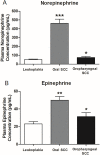Circulating catecholamines are associated with biobehavioral factors and anxiety symptoms in head and neck cancer patients
- PMID: 30125310
- PMCID: PMC6101398
- DOI: 10.1371/journal.pone.0202515
Circulating catecholamines are associated with biobehavioral factors and anxiety symptoms in head and neck cancer patients
Abstract
Studies have shown that stress-related catecholamines may affect cancer progression. However, little is known about catecholamine secretion profiles in head and neck cancer patients. The present study investigated plasma norepinephrine and epinephrine levels in head and neck squamous cell carcinoma (HNSCC) patients and patients with oral leukoplakia, as well as their association with clinicopathological and biobehavioral variables and anxiety symptoms. A total of 93 patients with HNSCC and 32 patients with oral leukoplakia were included. Plasma norepinephrine and epinephrine levels were measured by high performance liquid chromatography with electrochemical detection (HPLC-ED), and psychological anxiety levels were measured by the Beck Anxiety Inventory (BAI). Plasma norepinephrine and epinephrine concentrations were significantly higher in patients with oral and oropharyngeal squamous cell carcinoma (SCC) compared to non-cancer patients. Oral SCC patients displayed plasma norepinephrine levels about six times higher than oropharyngeal SCC patients, and nine times higher than oral leukoplakia patients (p < .001). Plasma epinephrine levels in oral SCC patients were higher compared to the oropharyngeal SCC (p = .0097) and leukoplakia (p < .0001) patients. Oropharyngeal SCC patients had higher plasma norepinephrine (p = .0382) and epinephrine levels (p = .045) than patients with oral leukoplakia. Multiple regression analyses showed that a history of high alcohol consumption was predictive for reduced plasma norepinephrine levels in the oral SCC group (p < .001). Anxiety symptom of "hand tremor" measured by the BAI was an independent predictor for higher plasma norepinephrine levels in HNSCC patients (β = 157.5, p = .0377), while the "heart pounding/racing" symptom was independently associated with higher plasma epinephrine levels in the oropharyngeal SCC group (β = 15.8, p = .0441). In oral leukoplakia patients, sleep deprivation and worse sleep quality were independent predictors for higher plasma norepinephrine levels, while severe tobacco consumption and higher anxiety levels were factors for higher plasma epinephrine levels. These findings suggest that head and neck cancer patients display sympathetic nervous system hyperactivity, and that changes in circulating catecholamines may be associated with alcohol consumption, as well as withdrawal-related anxiety symptoms.
Conflict of interest statement
The authors have declared that no competing interests exist.
Figures


References
-
- Cohen L, de Moor C, Devine D, Baum A, Amato RJ. Endocrine levels at the start of treatment are associated with subsequent psychological adjustment in cancer patients with metastatic disease. Psychosom Med. 2001; 63(6):951–8. - PubMed
-
- Ates O, Soylu C, Babacan T, Sarici F, Kertmen N, Allen D, et al. Assessment of psychosocial factors and distress in women having adjuvant endocrine therapy for breast cancer: the relationship among emotional distress and patient and treatment-related factors. SpringerPlus. 2016;5:486 10.1186/s40064-016-2136-2 - DOI - PMC - PubMed
Publication types
MeSH terms
Substances
LinkOut - more resources
Full Text Sources
Other Literature Sources
Medical
Research Materials

